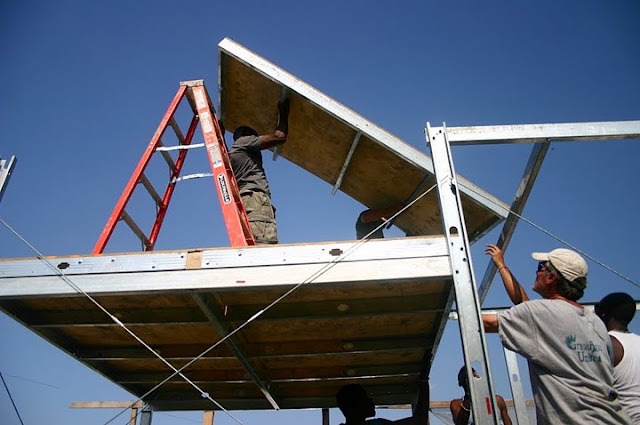Yesterday marked a decisive moment for Uber Shelter. For the last two weeks we have been touring camps and neighborhoods and meeting with many Haitians and aid workers in an attempt to better understand Haiti and find the right location to set up the Uber Shelter for evaluation.
On Monday night, Rafael and I sat down and discussed the pros and cons of each site where we can set up the shelter. Together we agreed on which family to give the shelter to, and yesterday we met with the family and announced our decision to them. Genesis, his wife Irene (shown above) and their new born son are living in an area of Port-au-Prince called Delmas 33, in one of the most populous IDP camps known as Adoken with over thirty thousand people. Genesis, is the elected president of one section in this large camp. Through his leadership he has helped implement projects to bring in shelter supplies and water tanks with purifiers for his community. He lives with his family inside a small, two-room house made of scrap wood, tarp, and a metal roof. It sits amidst a sea of tarps precariously arranged on an overcrowded hillside. Aside from cramped and insecure living conditions, one of the biggest issues is that none of the shelters are keeping families off the ground and dry. Every time it rains the mud and water flows under the walls and inside the shelter making everything wet. Last night it rained a lot, and on the roof top where Rafael and I are staying there was some flooding and all our clothes inside our tent got soaked. I slept inside the conference room and I thought about how it would feel if I had no other option but to sleep inside the flooded tent.
Genesis hustles different jobs in and out of the camp. He has set up a cyber cafe under a tarp in the camp and his wife runs a beauty salon (under a tarp) in the camp. The amount of entrepreneurship and ingenuity here would impress you. As mentioned before, he is the elected president of one section of Adoken and is well respected by his peers in the camp. We have wrestled with the idea or whether or not giving this shelter away in a camp is a responsible thing to do. How will his neighbors and others in the camp react to him receiving a transitional shelter while everyone else is living under tarps? Will they be jealous? Will there be any tension? I feel that Genesis' standing in the community and what has done for the people around him will make it understandable why he is receiving this shelter. Our assumptions could be wrong, but we, along with Genesis feel ok about giving this a shot.
On Sunday we went out with some friends at Grassroots and were hosted for a wonderful dinner by our good friend and translator Val. Inside his small wooden house we shared a delicious feast with his friends. With our plates full of traditional Haitian dishes--diri kole ak pwa, pikliz, salad kreson legim melanje ak bannan peze, poul ak sòs zonyon, vyann kabrit and so on--we watched his friends as they performed traditional and modern improvised songs and poems. We had a blast, and we plan to meet again this coming Sunday and we will make some dishes from our respective countries!











































